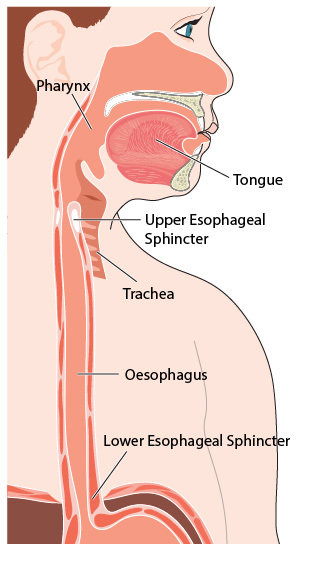Dry eyes are a common issue affecting many people. Symptoms range from uncomfortable foreign body sensation, burning, and itching to reddened eyes and blurred vision. Those affected often complain about tired, strained eyes and a significantly reduced quality of life.
The causes of dry eyes are diverse. In addition to external factors like screen work, air conditioning, or dry heating air, physical changes such as hormonal fluctuations or autoimmune diseases can also play a role. Treatment is usually limited to addressing the symptoms, for example with moisturizing eye drops or lid hygiene.
LPR: A Statistical Connection with Dry Eyes
In recent years, evidence has been accumulating that laryngopharyngeal reflux (LPR), also known as silent reflux, could also be associated with dry eyes. A recent study found that patients with dry eyes have an 8-fold increased likelihood to also suffer from LPR. The researchers examined 245 subjects, 152 of whom suffered from dry eyes. While only 13% in the control group showed signs of LPR, it was a whole 45% in the dry eye group.
This result sheds an entirely new light on the causes and treatment options for dry eyes. Because if almost half of all dry eye patients simultaneously suffer from LPR, it is not enough to only treat the symptoms. Instead, both conditions must be considered and treated as a unit.
In the following, I would like to elaborate on what LPR actually is, how it is connected to dry eyes, and what those affected can do to alleviate their symptoms. Because with the right knowledge and appropriate strategies, the quality of life can be improved in the long term.
LPR: Reflux in the Airways
Silent reflux, also known as laryngopharyngeal reflux (LPR), is a form of reflux disease that differs significantly from classic heartburn. While with heartburn, stomach contents flow back into the esophagus causing the typical burning pain behind the breastbone, with LPR it rises even further up into the throat and upper airways as well as into the lungs. Additionally, the reflux can reach the ears via the Eustachian tube.
Unlike classic esophageal reflux, LPR is not liquid but a fine aerosol, i.e., tiny droplets that mix with the inhaled air. One could also speak in simplified terms of an invisible, gaseous reflux.
As a result, LPR often causes symptoms that at first glance have nothing to do with the stomach. These include chronic cough, sore throat and hoarseness, frequent throat clearing, a coated voice, or the feeling of a lump in the throat. Many sufferers also experience nighttime coughing, breathing pauses (apnea), or even asthma. Because these symptoms are so nonspecific, LPR often goes unrecognized as the cause for a long time and remains untreated.
The aggressive mix of acid and digestive enzymes, especially pepsin, attack the tissue and lead to chronic inflammation. Studies have shown that pepsin can damage the cells of the throat mucosa and stimulate the production of mucus, which in turn intensifies coughing and throat clearing.
There are now also initial indications that LPR can even affect the eyes. If stomach acid and pepsin reach the eyes via the tear ducts, they can cause irritation, inflammation, and damage to the delicate tear glands there. This could explain why people with LPR often also suffer from chronically dry eyes.
How Can Reflux Reach the Eyes?
It is unclear exactly how the reflux reaches the eyes, though there are few possibilities.
Since the stomach enzyme pepsin has been detected in the eyes of LPR patients in studies, the reflux must have somehow made it there.
One possibility would be that the LPR migrates through the tear duct that connects the eye and nose. Possibly, the gaseous LPR is also simply exhaled, and the exhaled air then comes into contact with the eye surface.
Other Causes of Dry Eyes
Of course, one should not forget that most likely reflux at most has an exacerbating effect on dry eye, while the underlying causes are likely to be different.
In our modern digitized world, screen work in particular plays a crucial role for dry eye. More and more people spend many hours on computers, tablets or smartphones – whether at work or in their leisure time.
Dry Eyes at the Screen: How Computer Work Reduces Blink Frequency
The problem: When staring at the screen, our blink frequency decreases by up to 60%. But every blink is important to moisten and protect the eye surface with tear fluid.
If we blink too little, the eyes dry out and become irritated more quickly. In addition, the blue light and contrasts of digital screens strain the eyes further.
Further Exacerbating Influences for Dry Eyes
Adverse environmental conditions can also cause the eyes to dry out. These include air conditioners (e.g. in cars or offices) that dehumidify the air, or dry heating air in winter. Those who spend a lot of time outdoors also expose their eyes to wind, cold and UV radiation – all factors that can destabilize the tear film.
Women in menopause in particular often suffer from dry eyes. This is due to hormonal changes that affect tear production. Immune system diseases such as rheumatism or Sjögren’s syndrome can also attack the tear glands and disrupt their function.
Last but not least, certain medications can also inhibit tear production and thus lead to dry eyes. These include, for example, some antidepressants, beta-blockers or antihistamines. The widely used acne medication isotretinoin (better known as Accutane) can also severely and irreversibly damage the tear glands.
So there are many different causes for dry eye – LPR is just one of them. Nevertheless, it is worth having a possible reflux disease investigated, especially in case of persistent symptoms. Because often it is the interplay of several factors that irritates and dries out our eyes in the long run.
It is all the more important to identify and specifically treat the individual triggers. Only in this way can we keep our eyes healthy in the long term and prevent complaints. How to best proceed and what treatment options are available, I will reveal in the next section.
Treatment Options for Dry Eyes
If you suffer from dry eyes, there are various ways to alleviate the symptoms and improve eye health.
Artificial Tears and Moisturizing Gels
A basic option is artificial tear fluids and moisturizing gels, which you can obtain as over-the-counter products at the pharmacy. They replace the missing tear fluid and ensure better wetting of the eye surface.

However, such products can also contain preservatives that additionally irritate the eyes in the long run. Preservative-free products in single-dose containers or other preservative-free alternatives are better. When applying, be sure to observe good hygiene and avoid contact of the dropper tip with the eye to prevent contamination.
Changes in Lifestyle Habits
At least as important are changes in your lifestyle habits. Especially when working at a screen, you should take regular breaks and blink consciously to relieve your eyes. The 20-20-20 rule can help you with this: Every 20 minutes, look at a point at least 20 feet (about 6 meters) away for 20 seconds. This relaxes the eye muscles and gives the tear fluid time to spread evenly.
A humidifier can also help keep eyes moist – especially in winter when heating air dries out the mucous membranes. Also, make sure you have a sufficient distance from the computer monitor (at least 50 cm), glare-free lighting and an ergonomic sitting position. All of this relieves your eyes and prevents symptoms of digital eye strain.
Treatment of LPR
If you continue to suffer from dry eyes despite these measures and perhaps even have symptoms of LPR, it is advisable to specifically address the cause. I go into more detail on this topic in my guide to treating silent reflux (LPR).
Blinkr: An Innovative Blink Reminder App to Prevent Digital Vision Syndrome
As you have already learned, excessive screen work is one of the main risk factors for dry eyes. When we stare at a monitor for a long time, we often forget to blink, which dries out the eye surface. However, in many occupations or hobbies, it’s impossible to avoid computer screens. The medical term for the resulting symptoms, like dry eyes and eye strain, is computer vision syndrome.
Fortunately, there is now a clever solution to the digital eye strain part of dry eyes: Blinkr, an AI-powered blink reminder app.
What is Blinkr, and How Does it Work?
Blinkr is an innovative blink reminder that monitors your blinking frequency during computer screen work. The software uses your computer’s webcam and recognizes when you blink – and when you don’t – using a proprietary AI algorithm.
If Blinkr detects that you haven’t blinked for a while, a gentle reminder appears on your computer screen. This disappears automatically as soon as you blink again. This way you are regularly reminded to blink without being pulled out of your concentration.
Over time, your brain gets used to blinking more often – even without the reminders. In a sense, you train your blink reflexes and do your eyes some good.
The Benefits of Using a Blink Reminder
Regular use of Blinkr offers many benefits for your eye health:
- Reduction of digital eye strain and dry eyes during prolonged computer use
- Promotion of healthy blinking habits
- Improvement of overall eye comfort during long work or gaming sessions
- Easy to use in the background without distracting you
Blinkr keeps an eye on your eyes so you can focus on what’s important – whether it’s work or your favorite game.
How to Use Blinkr
Using Blinkr is simple:
- Download the Blinkr app and install it on your computer.
- Make sure your webcam is connected and ready to use.
- Launch the app and adjust your camera so that your face is clearly visible.
- Let Blinkr run in the background while you work or play on the computer.
- The app reminds you to blink when you forget to for a while.
That’s all you need to do! Blinkr works unobtrusively in the background and protects your eyes without interrupting you.



